Courbet and the Mirror of Venus
Reflections on defaced artworks & the archetypal feminine
On May 6th, Gustave Courbet’s painting L’Origine du Monde (1866), along with five other artworks, was tagged, spray painted with the words “Me Too” by feminist performance artist Deborah de Robertis. The painting is part of an exhibit at the Centre Pompidou in Metz, titled “When Art Meets Psychoanalysis,” centered on the ideas of French psychoanalyst Jacques Lacan, who was the owner of the Courbet painting for almost thirty years.
The painting itself is unforgettable and iconic, almost always part of surveys of modern art. L’Origine is a close-up of a woman’s lap, torso, and right breast, her genitalia shown candidly. Courbet, the leading figure of painterly “realism” in the mid-19th century, believed in the importance of depicting only what could be observed, breaking away from, and provoking the rebuke of, the academic conventions of his time. He declared that “realism is democracy in art,” and envisioned himself as an artist who would work to overturn academic, conservative values in art and in French society at large. His work influenced so much of the avant-garde painting that followed, namely the Impressionist and Cubist movements of the 19th century.
Deborah de Robertis, the Luxemborg born artist who defaced L’Origine has staged similar revolts in the past. In 2014, she sat beneath L’Origine in the Musee d’Orsay, undressed from the waist down, legs spread, mirroring the painting above her. This was captured in one of her own photographs which she defaced (Miroir de l’Origine du Monde) featured in the same exhibit. She has repeated the same vulva-exposing pose in front of the Mona Lisa and in the Garden of Apparitions, the site of the supposed appearance of the Virgin Mary in 1858.
De Robertis has titled this most recent performance/protest at the Pompidou On ne sépare pas la femme de l’artiste (The Woman Cannot Be Separated from the Artist), and stated that the act was “intended to highlight the misogynistic divide present in the art world.”
But of all the works to tag in feminist protest, is L’Origine really deserving of such treatment? In addition to defacing her own work and the Courbet, de Robertis tagged a work by Louise Bourgeois and contemporary artist Valie Export, a painting of Export sitting on a chair, with her vulva exposed. Export released a statement denouncing the act, writing that the “autonomy of [her] artwork is destroyed.” If de Robertis’s acts are part of a feminist project, why are feminist artworks being targeted? And what is this Courbet doing in a group show with other prominent feminist artworks?
I think that L’Origine occupies a strange, ambiguous place in the history of art, existing in that liminal space between the archetypal erotic and the pornographic. While it may appear as a work that objectifies the female body, there is simply nothing inherently sexist about its depiction, and we have no biographical proof that Courbet created it with a sexist intention. It is as direct an expression of fertility as fetish objects from the Paleolithic, which also often presented fertility goddesses as headless, legless, disembodied breasts, hips, and vulvas. L’Origine’s powerful simplicity is, to me, an affirmation of the archetypal feminine.
L’Origine’s Origins
I remember the first time I saw this painting in my own art history class, sitting in the dark cool lecture room at my university, the huge image of a vulva suddenly radiating from the screen. It’s shocking enough to elicit an immediate giggle, so unadorned and frank in its presentation of the female body. But there is also something deeply beautiful about it, formally. The curving softness of the body, the relaxed pose. It is a body that feels so organic and real, recalling the contours of a seashell, or some other oceanic Aphrodisian symbol.
This painting shocked and scandalized audiences in 19th century Paris when it was first debuted. However, the fact that this was shocking speaks more to the misogyny of the society at large than to work itself. Appearing just a few years after Édouard Manet’s Olympia shocked viewers in 1863 with its own unadorned presentation of a reclining nude, Courbet’s work elicited typical bourgeois reactions. His contemporary Maxime du Camp decried it as pornographic and offensive.
Though that may seem an odd criticism given the work’s relatively tame nature, its merely elegant realism, it must be said that the work may have been commissioned by the Ottoman diplomat Halil Şerif Pasha, a collector of “erotica.” Other works in his collection were Le Bain Turc by Ingres, and Courbet’s Le Sommeil, both of which depict women bathing or sleeping, but are still not inherently pornographic. Regardless, L’Origine did not remain on display for the public for long. It was to pass through the hands of several men. After its initial owner, Pasha, ruined his finances due to gambling, the work was in 1868 auctioned off.
It disappeared from collections and reappeared in an antique shop, discovered by the French novelist Edmonde de Goncourt in 1899. The painting was then purchased by Hungarian art collector Ferenc Hatvany in 1910, subsequently looted by Soviet soldiers during WWII, and ransomed back by Hatvany, who owned it until 1947. In 1955 it was purchased by Jaques Lacan, who possessed it for about three decades, though no color reproduction existed, and scholars by the 1980’s doubted that it had survived. Feminist art historian Linda Nochlin was able to locate it, and secure a loan of L’Origine for an exhibit at the Brooklyn Museum in 1988, titled “Courbet Reconsidered,” of which she was one of the main organizers. And so now, in 2024, at a show based on the ideas of Lacan himself, the work appears again, at the center of a scandal.
Headless Women, Fertile Bodies
In the past week, critical response to the vandalism at the Pompidou has either celebrated the act or decried it as pointless. In the Guardian, Dale Berning Sawa commented, “The performer who wrote ‘MeToo’ on Gustave Courbet’s The Origin of the World is right to think the painting is misogynistic: the model doesn’t even have a face!” And while the painting scandalized sexist audiences in the 1860s, more recent feminist approaches to art history may see L’Origine as similar to other sexist works which have reduced women’s bodies to mere objects to be consumed, dehumanized, diminished, or dismembered.
But is this really a fair critique of the work? We know, for instance, that Courbet was soon jailed for his involvement in the Paris Comune, which implemented a system of progressive socialism, closing Roman Catholic Churches and schools. This project was feminist and anarchist in its aims. Courbet was subsequently exiled to Switzerland, forced to leave France in 1873, where he remained until his death.
Thinking back to my first encounter with this painting, and the way I’ve felt about it ever since, the title L’Origine du Monde always struck me as, yes, a bit tongue in cheek, but also celebratory of the creative power of the motherhood. To conservative viewers in the 1860s, the title may have even served to augment the shock of the artwork. Not only was a woman’s vulva on full, inescapable view, but the title implied also that the mother was the origin of all things.
There is, of course, the matter of the missing head, as noted by Sawa. According to her logic, to cut off a woman’s head is to remove the part of the woman that can think, argue, talk back, cry out in protest, and therefore she is dehumanized. As a feminist, I can appreciate that critique of Courbet’s work, and easily see how reducing a woman to her genitals is dehumanizing. But on this matter, my mind turns to earlier versions of the feminine in art.
Our earliest extant artworks issue forth from the Paleolithic, much of which survives in the form of what are presumed to be ritualistic figurines. One of the most famous is the Venus of Willendorf, which shows a woman’s body, her breasts and hips disproportionately large in comparison to the head. She is the Great Mother, the origin of the world. Many other figurines and sculptures were made in this likeness, showing the headless body of a woman, her reproductive organs emphasized by the artist. This art was likely created with the purpose of propitiating the fertility gods, ensuring the continued health and vitality of the human race. The form of a woman boiled down to the essential shapes—circle of breast and triangle of vulva—is a nod to her amazing procreative power. Nor Hall writes:
Vulvar V’s and the more abstracted triangle represent woman as fertile source. ‘The Pythagoreans held the triangle to be Urgestalt (original form), not only because of its perfect form, but also because it was the archetype of universal fecundity.’ Fecunda is femina: fecund, or fertile, and female are one. The mons veneris of the Mother is the triangle of Aphrodite, the “mound of Venus,” the mountain connecting man and woman, earth and sky.
(The Moon & the Virgin, 44)
Though we don’t know for sure that the sculptures had a definite, particular function, historians tend to believe that they had a ritual, sympathetic magical function. Enlarging the breasts of the Venus form suggests an abundance of rich breastmilk with which to nourish children, strengthening them against life’s adversities. The enormous hips and belly suggest an easy passage from gestation to the life of the child outside the womb: the body here in its voluptuous form celebrates the creation of something from nothing, made possible by the lunar ability to shape shift. The extreme depiction of maternal form reflected the extreme difficulty and danger of sexual reproduction.
The difference, of course, between the Paleolithic era and today is that in the former, these artworks depicting “woman as breast” or “mother as vulva” were being celebrated and cherished. Now, we do live in the era of “Me Too,” where feminisms are grappling with their own mission, trying to find a way to expose and speak to the cruelties of the patriarchy, while trying to adapt themselves to the needs of an intersectional world.
Our world today is so divorced from fertility magic that we cannot look at a woman’s body without attaching pornographic associations to it. The once magical rites of reproduction are controlled, now, to a terrifying degree, and women’s bodies are the subject of legislation, rather than veneration. I’m not convinced that tagging the “Me Too” slogan on artworks is doing as much for the cause as de Robertis believes.
Separating the Woman from the Artist
The more I contemplate this, the idea of “mirroring” looms larger. On seeing L’Origine du Monde, I feel to some extent that I am being confronted with a mirror of my own body, from an angle, of course, one which I cannot see without a mirror. Feminist art historians have suggested that the only way to experience the female body from this vantage point is to view it through the lens of the male gaze. L’Origine was also a mirror from which the French bourgeois could not look away, reflecting a fact of life: women’s bodies created the world around them. De Robertis’s uncanny exposing of her own body in front of L’Origine, mirroring its pose, serves in part to replace the missing head of the painting’s subject, redressing the wrongs of the original, so to speak, making it into a self-aware work.
Jacques Lacan, whom this exhibit was centered on, gave us the psychoanalytic concept of the “mirror stage” a moment in childhood development, taking place between 6 and 18 months, when a child is able to recognize themselves in the mirror, and is thus able to start cultivating a sense of self and identity.
Very broadly, does L’Origine not create a mirror stage moment for us, when beholding it? Is it not valuable in reminding us of where we come from? And if and when we are shocked by that reminder, what kinds of psychological alchemies does it evoke in us? We should embrace L’Origine, which has already prompted so much feminist response. It shows us the origin of the world, and in doing so, births endless works of art.






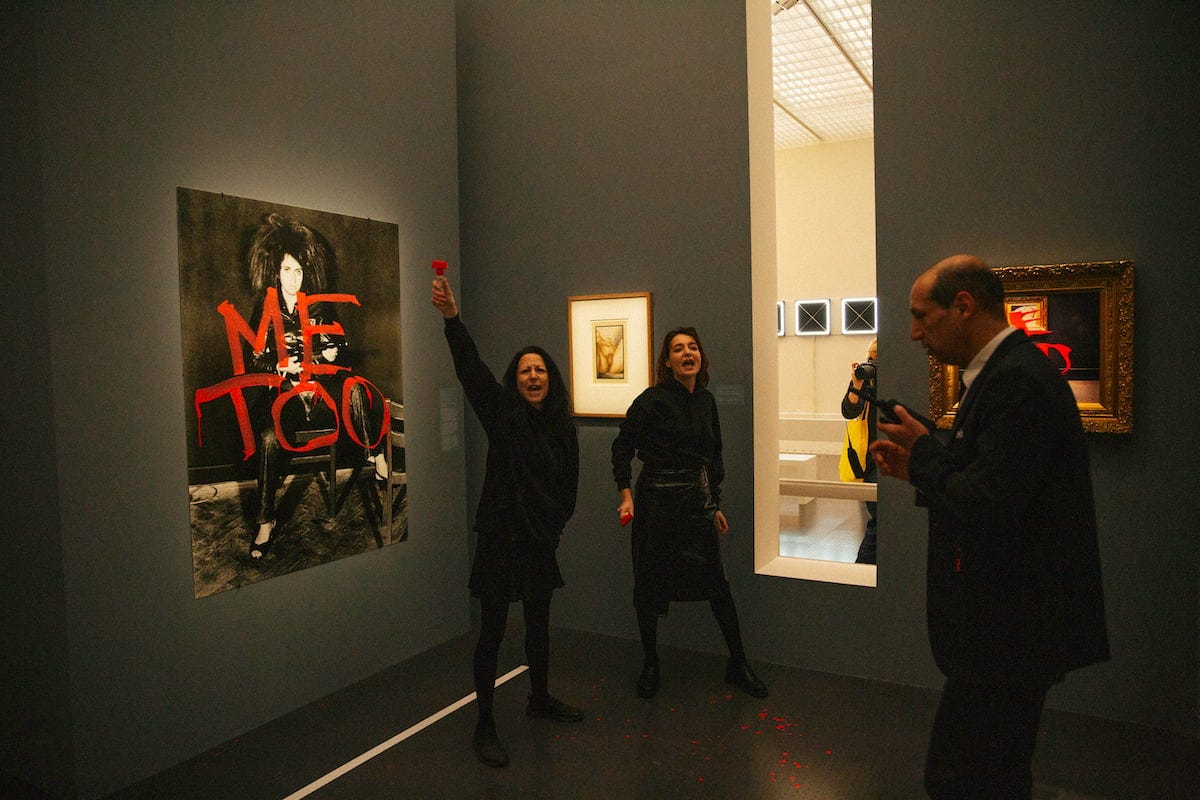
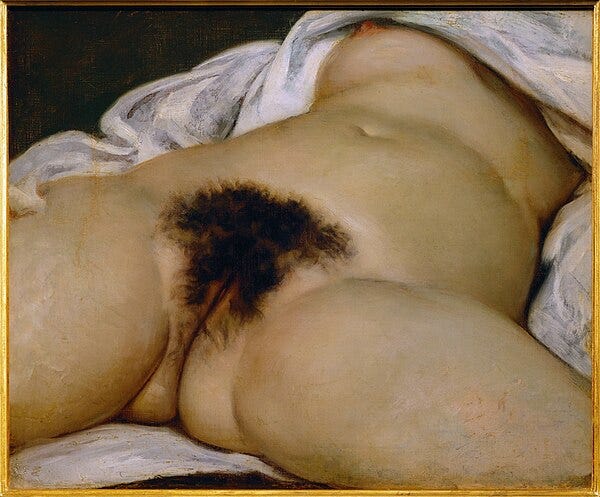

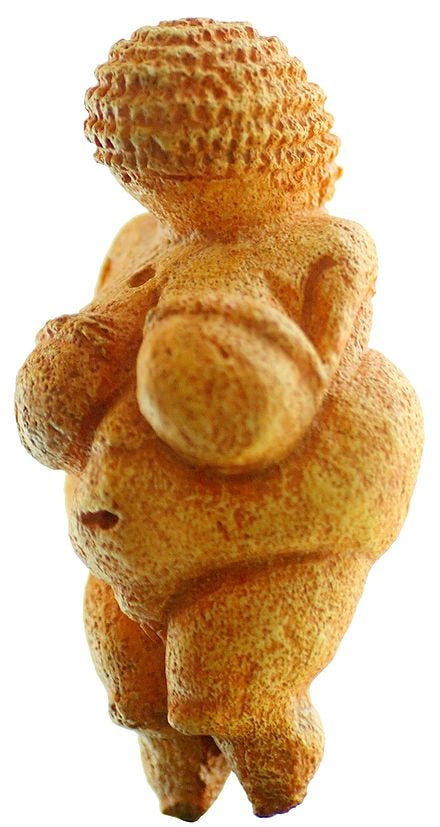
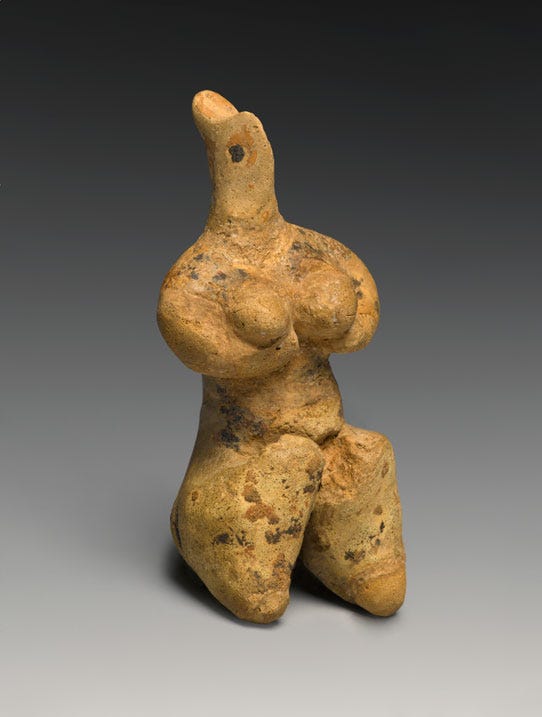
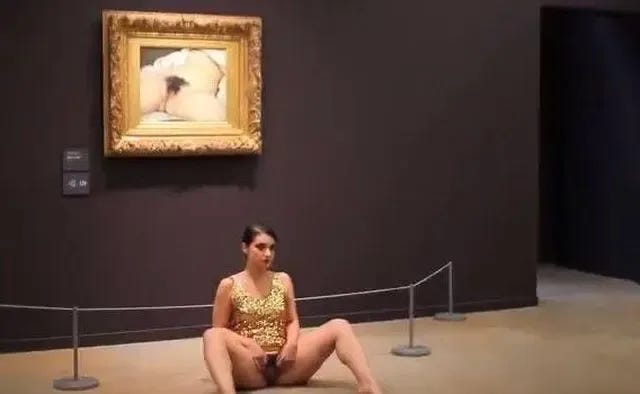
I’ve always loved this painting, the realness especially. It’s never felt objectifying to me, and the idea that the angle makes it “the male gaze” is weird too… as if I, a woman, couldn’t also look at someone’s vulva from this angle?
Really enjoyed your reflection on this ❤️
This is a great analysis of this question. In my history classes I often show Orientalist paintings to my students, including the one you mentioned, and although I don’t necessarily use the same terms, I try to get them to see both “the male gaze” and the “western gaze” as intertwined. I don’t see that in the Courbet painting at all.